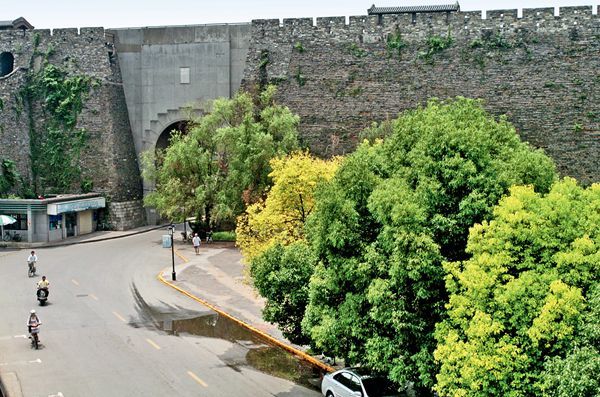Nanjing:city of memories
 0 Comment(s)
0 Comment(s) Print
Print E-mail China Today, January 19, 2017
E-mail China Today, January 19, 2017
Capital of Six Dynasties
Nanjing was in fact China's capital for more than 10 dynasties. So why is it generally known as Capital of Six Dynasties?
|
The city wall built in the Ming Dynasty was as long as 33,676 meters. More than 600 years later, 21,351, making it China's longest extant city wall. |
The Six Dynasties refers to the specific period of Chinese history from 222 to 589, during which time there were Wu (222-280), Eastern Jin (317-420), and four successive dynasties – Song, Qi, Liang, and Chen – which are normally collectively called the Southern Dynasties (420-589).
All these states maintained their capital at Nanjing, hence the nickname, "Capital of Six Dynasties."
At that time Nanjing was a metropolis by any standards, with a population exceeding one million. The first city to adopt a symmetrical layout with the north-south axis at its center, Nanjing's architectural design exerted a far-reaching influence on later generations both in China and other East Asian countries. It is outstanding in the history of development of China's ancient capitals.
Nanjing was named capital upon the establishment of the Southern Tang Dynasty (937-975). The stable social environment over the next 39 years brought both economic and cultural development, particularly in literature, art, calligraphy, and music.
Li Yu (937-978), the last Southern Tang ruler, was culturally versatile, excelling in calligraphy, painting, poetry, and music. His poetic works, especially in the form of Ci (also called lines of irregular lengths), have been appreciated for generations.
|
A museum that reflects the Chinese imperial civil examination system is built on the site of Jiangnan Examination Hall. |
In 1368, Zhu Yuanzhang (1328-1398) proclaimed himself emperor in Nanjing and established the Ming Dynasty (1368-1644). Nanjing thus became the designated national political, economic and cultural center. Zhu spent 27 years designing and building a city wall – 33,676 meters long – to encircle his capital. More than 600 years later, 21,351 meters of wall still stands, making it China's longest surviving city wall.
In 1421, the third Ming emperor moved the capital to Beijing, and Nanjing was demoted to a secondary capital. The grand Ming Palace was destroyed by successive wars and disasters in later centuries, but people can still catch a glimpse of its architectural style and innovation through Beijing's Forbidden City, which was modeled on the Ming Palace.
In 1842, at the end of the First Opium War, Britain and the government of Qing Dynasty (1644-1911) signed the Treaty of Nanjing, marking the start of the modern period of China.
In 1853, during the Taiping Rebellion launched by peasants from South China, the Taiping Army captured Nanjing as its seat and held the city for 11 years.
In 1912, Dr. Sun Yat-sen announced the establishment of the provisional government of the Republic of China in Nanjing, and was inaugurated as Provisional President of the Republic.
On April 23, 1949, the People's Liberation Army captured Nanjing, so ending the Kuomin-tang's status as the ruling political party of China's mainland.
After the founding of the People's Republic of China in 1949, Nanjing was designated capital city of Jiangsu Province.








Go to Forum >>0 Comment(s)